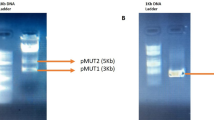Abstract
A recently isolated Escherichia coli strain (3TF4) survived an acid shock that mimicked the low pH of the human gastric stomach (pH 2, 1 h), but this survival was highly influenced by prior growth conditions. Only 0.01% of the stationary phase cells that had been grown anaerobically in a carbonate medium (2 mg glucose and 0.25 mg yeast extract per ml, 40 mm sodium carbonate, final pH 6.5) survived the acid shock, and the survival of exponential phase cultures was even lower (0.0001%). Small amounts of Trypticase (1.5 mg/ml) increased the survival as much as 5000-fold, but cultures that were provided with higher concentrations of Trypticase (7.5 mg/ml) did not reach the stationary phase in 24 h and were more acid sensitive. Sodium acetate (50 mm) also increased acid resistance, and the increased acid shock survival was greater for the cells that had reached the stationary phase (100 versus 1000-fold, respectively). E. coli 3TF4 cultures that had been grown aerobically in Luria broth were already so acid resistant (survivals greater than 40%) that they did not respond to sodium acetate. E. coli 3TF4 cultures that were refrigerated (5°C, 7 days) were nearly as acid resistant as those that were immediately subjected to acid shock (pH 2.0, 1 h).
Similar content being viewed by others
Author information
Authors and Affiliations
Additional information
Received: 20 December 2000/Accepted: 7 February 2001
Rights and permissions
About this article
Cite this article
Jarvis, G., Russell, J. Differences in Escherichia coli Culture Conditions Can Have a Large Impact on the Induction of Extreme Acid Resistance. Curr Microbiol 43, 215–219 (2001). https://doi.org/10.1007/s002840010290
Issue Date:
DOI: https://doi.org/10.1007/s002840010290




